Wayne State University
| Wayne State University | |
|---|---|
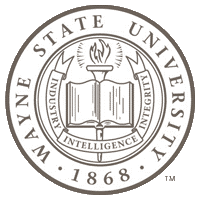 |
|
| Motto | "Industry, Intelligence, Integrity" |
| Established | 1868 |
| Type | Public university |
| Endowment | $204 million[1] |
| President | Dr. Jay Noren |
| Academic staff | 2,700 |
| Students | 31,786 (Fall 2009) |
| Location | Detroit, Michigan, |
| Campus | Urban |
| Colors | Green and gold |
| Sports | Warriors |
| Nickname | Warriors |
| Website | wayne.edu |
Wayne State University is a public research university located in Detroit, Michigan, in the city's Midtown Cultural Center Historic District. Founded in 1868, WSU consists of 13 schools and colleges offering more than 350 major subject areas to over 31,000 graduate and undergraduate students. It is currently the third largest university in the state of Michigan. The WSU main campus encompasses 203 acres (822,000 m²) linking 100 education and research buildings in the heart of Detroit. It also has six extension centers in the Metro Detroit area providing access to a limited selection of courses. The institution is a notable engine in metro Detroit's educational, cultural, and economic landscape, as manifested through efforts such as its 75-acre (300,000 m2) research and technology park and its hosting of the Detroit Festival of the Arts.
Contents |
History
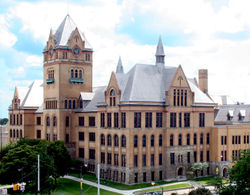
The first component of the modern Wayne State University was established in 1868 as the Detroit Medical College, now the School of Medicine. In 1881, the Detroit Normal Training School was established, now the College of Education. Old Main Hall was built in 1896 as Central High School, which later began adding college classes in 1913. Those classes evolved into the Detroit Junior College in 1917, the College of the City of Detroit in 1923, and now WSU's College of Liberal Arts and Sciences.
In 1919, David L. Mackenzie - who served a dual role as Principal of Detroit Central High School and Detroit Junior College - was officially appointed first Dean of the college that he had originated in 1917. With Mackenzie at the helm, Detroit Junior College grew to become the third largest institution of higher learning in Michigan. The college was granted four-year degree status in 1923 - becoming the College of the City of Detroit; David L. Mackenzie continued as Dean until his death in 1926.
In 1920, the Merrill-Palmer Institute for child development was founded. It is presently known as the Merrill-Palmer Skillman Institute.
In 1927, the Detroit Board of Education dedicated its newest high school to the memory of David L. Mackenzie. The three-story structure still stands on the city's west side at 9275 Wyoming Avenue; Mackenzie High School closed its doors for the last time in June, 2007.
In 1933, the Detroit Board of Education organized the six colleges it ran- liberal arts, medical, education, pharmacy, engineering and a graduate school- into one university. In January 1934, that institution was officially named Wayne University.
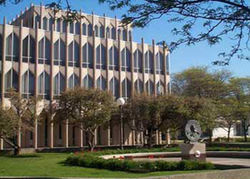
Wayne University continued to grow, adding the School of Social Work in 1935, the Law School in 1927, and the School of Business Administration in 1946. Wayne University was renamed Wayne State University in 1956, and the institution became a constitutionally established university by popularly adopted amendment to the Michigan Constitution in 1959.
As Wayne State University, the institution grew with the additions of the College of Lifelong Learning in 1973, the School of Fine and Performing Arts and the College of Urban, Labor and Metropolitan Affairs in 1985.
The University Libraries have grown to include six libraries, the School of Library and Information Science and the Office for University General Education.
Over the last few years, WSU has been aggressive in constructing new green glass buildings, including a new Welcome Center, which was controversial because of its cost and the displacement of several local businesses. Several new residence halls have been built, to further university officials' goal of moving the college away from a commuter school.
Campus
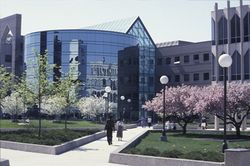
Wayne State's campus is located in the heart of Cultural Center Historic District, the home of renowned museums, galleries and theatres, most within walking distance. The WSU main campus encompasses 203 acres (0.82 km2) of nicely landscaped walkways, gathering spots, linking over 100 education and research buildings.[2] The campus is urban and features many architecturally interesting buildings. Some notable examples include Helen Deroy Hall, the Education Building, the Maccabees Building, Old Main, McGregor Memorial Conference Center, Chatsworth Tower Apartments, and Hilberry Theater. Many of these buildings were designed by notable architects such as Albert Kahn and Minoru Yamasaki.
The Cass corridor would be considered one of the University's most notable surroundings, with a venerable history and culture that has left an imprint on many of the WSU alumni. Many notable events have taken place on or near the campus as a result of its unique location. Artists that got their start here include Chuck & Joni Mitchell, Alice Cooper, The White Stripes, The Detroit Cobras, MC5, The Stooges, Savage Grace, Ted Nugent, Grand Funk Railroad, the Red Hot Chili Peppers recording their Freaky Styley album, the publication of Creem Magazine, the first rock journal, the first to use the terms "punk rock" and "heavy metal" and the first to give recognition to music of the likes of David Bowie, Iggy Pop, The Smiths, among many others. The now razed Tartar Field was home to WABX's free Sunday concerts in the late 1960s and early 1970s featuring many of these musicians.
Important events have also taken place on campus, such as Edmund Gettier's refutation of the "justified true belief" theory, which shook 2500 years of epistemology.
Libraries
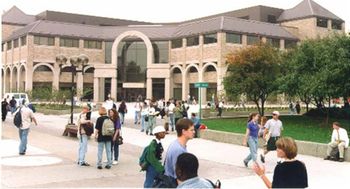
With approximately 3.4 million volumes, the Wayne State University Library System houses the 68th largest collection in the United States, according to the American Library Association.[3]. Consisting of 6 libraries all of which offer full wireless connection, reference and research support, interlibrary loan, circulation and course reserve services, document delivery and library and information literacy programs. The libraries provide a range of study environments from silent to interactive and includes a 24-hour facility computer lab/study area, the System ranks among the top libraries according to the Association for Research Libraries[4][5]
- Shiffman Medical Library, located on Wayne's medical campus, houses the university's medical collections and is the sole library of the university's medical school.
- Arthur Neef Law Library, located on the Northern most section of the main campus, houses the university's law collections and is the sole library of the university's school of law.
- Science and Engineering Library, located at the South end of Gullen Mall, contains information resources supporting the physical and natural sciences, mathematics, engineering, nursing, nutrition and food science. The Library's holdings also include maps, government documents, several special collections, and one of the largest technical journal collections in southeastern Michigan.[6]
- Purdy/Kresge Library, located near the center of main campus and serves as the primary research library for the social sciences, humanities, arts, education, and business disciplines. It contains print and electronic resources to meet the research and instructional needs of faculty, graduate students, and upper level undergraduates in these disciplines. It also houses the University's main government documents collection and the offices of the university's Media Services Department.[7]
- David Adamany Undergraduate Library (UGL), Located on the center of Gullen Mall, has over 700 computer workstations providing students with access to electronic resources. Its book and magazine collection is intended to support the learning needs of 1000 and 2000 level undergraduate courses. It houses the University libraries media collection of approximately 8000 videos, DVDs, laser discs and audiotapes. The UGL provides students with information on careers, computers, and student survival skills. The Library also has a 24 hour computer lab/study area.[8]
- Walter P. Reuther Library of Labor and Urban Affairs located on the eastern most portion of Wayne's main campus, on Cass Ave, This smaller library houses predominantly historical archives.
Housing
The university provides housing in the form of apartment living and residence hall living. All buildings are equipped with connection to the university computer system, wireless internet connection, laundry rooms and a 24 hour help desk. [1]
Current university owned apartment buildings include University Tower, Chatsworth Tower, and Helen L. DeRoy Apartments. The Sherbrooke Apartments were closed in September 2008. The Forest Apartments were closed after the 2004-2005 school year and have since been demolished. The Chatsworth Annex apartments were demolished, and replaced with greenspace and volleyball courts after the 2004-2005 school year.
In the hopes of bringing more residents to campus, Wayne State opened two dormitory-style residence halls in 2002 Yousif B. Ghafari Hall (formerly North Hall) and 2003 Leon H. Atchison Hall (formerly South Hall). This was the first time since the closing of the Newberry Joy Dorms in 1987 that the University offered dorm living. For the Fall 2005 semester, the university opened The Towers Residential Suites. This residence hall is open to undergraduate (sophomore and above) and graduate students. The Towers Café is the largest on-campus dining facility and is supplemented by Warrior Dining, located in Ghafari hall.
- Ghafari/Atchison Hall provides housing for first- and second-year students only. Halls feature double occupancy rooms, fully furnished with private bath. Found on each floor are study rooms and social lounges all equipped with wireless high speed internet.[9]
- The Towers Residential suites, serving sophomore, junior, seniors, graduate and professions students, is an 11 story tower, with views as far as the Ambassador Bridge. The majority of rooms are suite style, containing four bedrooms attached to a shared living space. There are also studio rooms available. Within the building is a café-style dining hall, a mini Barnes & Noble bookstore and multiple fitness rooms.[10]
- Chatsworth Tower Apartments available to graduate and professional students only, is a 9 story historic landmark built in 1929. Featured in this structure are large comfortable studio and one bedroom apartments with fine ornate woodwork.[11]
- Helen L. DeRoy Apartments is a fifteen-story building built in 1972. With a total of 258 units; studio, one- and two-bedroom units offering residence to graduate and professional students only.
Units are equipped with wireless internet access, cable access for a monthly fee, central air conditioning, with a refrigerator and stove provided.[12]
- University Tower, this 300 unit complex opened in 1995, offers one, two, and three bedroom apartments as well as family units to junior, senior, graduate or professional students. Each apartment is wired for access to the university's computer network. The first floor offers wireless internet access, a study lounge, large laundry facility, and a childcare center. Wayne State's WDET radio station is also located on the first floor.[13]
Satellite campuses
Wayne State has six satellite campuses in and around the Metro Detroit area. The locations are:
- Harper Woods High School, Harper Woods
- University Center at Macomb Community College, Clinton Township
- Lamphere High School, Madison Heights
- Oakland Center, Farmington Hills
- University Center at St. Clair County Community College, Port Huron
- Wayne County Center, Detroit
Academic profile

Wayne State's comprehensive academic offerings are divided among 13 schools and colleges: the School of Business Administration, the College of Education, the College of Engineering, the College of Fine, Performing, and Communication Arts, The Graduate School, the Law School, the College of Liberal Arts and Sciences, the College of Library and Information Science, the School of Medicine, the College of Nursing, the Eugene Applebaum College of Pharmacy and Health Sciences, the Irvin D. Reid Honors College, and the School of Social Work.[14]
Fall 2009 enrollment for the University was 31,786 students, the 28th-largest enrollment among the United States' 270 national, public, four-year, doctoral-degree-granting institutions. WSU also has the second largest international enrollment in Michigan with 2,783 international students and 750 visiting scholars from almost 100 countries. With more than 1,000 students, Wayne State University School of Medicine is the largest single-campus medical school, and the third-largest overall, in the United States.[15] The School of Medicine is the first medical school in the country to implement a comprehensive radiology curriculum intertwined throughout the four year M.D. Course as an extension of the Advanced Diagnostic Ultrasound in Microgravity Study.[16]
Wayne State University is Michigan's only urban research university, and is renowned particularly for its contributions in the sciences. Wayne State University is classified as a Research Intensive University (Very High research activity), or RU/VH, by the Carnegie Foundation, the same classification as the University of Michigan - Ann Arbor, Michigan State University, Harvard, and Stanford.[17] Wayne State is a constitutionally autonomous educational institution in the State of Michigan along with Michigan and Michigan State.
According to the 2006 Academic Ranking of World Universities, Wayne State University ranked in the 201-300 range worldwide, placing in the same tier as Brandeis University, Georgetown University, George Washington University, Syracuse University, University of Notre Dame, and Wake Forest University, among others [18]. Wayne State ranked 63rd among American universities according to the National Science Foundation Research Rankings [19]. The 2007 "America's Best Colleges" list compiled by US News and World Report placed Wayne State in the Fourth Tier among "national", doctoral degree-granting institutions within the United States.[20]
Academics and rankings
| ARWU World[21] | 201-300 |
|---|---|
| USNWR National University[22] | Tier 4 |
Several of Wayne State's individual programs are well regarded. The School of Medicine ranked 22nd among the nation's 125 medical schools, according to the National Science Foundation, while its physics and physical science programs ranked in the top 50 nationwide [19][23]. The Law School has been ranked in the top 100 programs in the US News Law School Rankings, though its ranking fluctuates.[24]. The School of Library and Information Science is ranked in the top 20 programs in the country. The doctoral program in the College of Nursing was ranked fifth in the country [25]. Wayne State also is known for its strong urban policy programs, ranking 20th in the nation according to US News and World Report [26]. Wayne State's Honors Program was recently elevated from program status to becoming a full Honors College, named in honor of the university's ninth president Irvin Reid. The Honors College curriculum affords students the opportunity to become immersed in the Detroit community, participate in service learning, and perform meaningful undergraduate research.
Financials
Tuition at Wayne State is among the lowest of Michigan's 15 public universities, even while WSU maintains its status as one of only three universities in the state ranked in the top research category of the Carnegie Foundation for the Advancement of Teaching.[27] Fall 2009 tuition for in-state lower division students (59.99 credits or less) is $252.35 per hour, while in-state upper division students (60.00 credits or more) pay $297.45.[28]
Student life
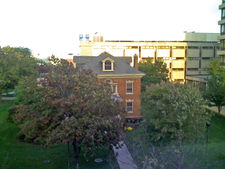
Programs abroad
Wayne State offers an array of choices with over 30 abroad programs, some being as short as two months in length with others lasting an entire year. As of 2009 students have their pick from numerous countries including Belize, Brazil, Canada, China, Croatia, Czech Republic, England, Finland, France, Germany, Ghana, Italy, Japan, New Zealand, Mexico, Poland, Puerto Rico, Russia, Spain, South Africa, and Turkey. With programs offering studies in art, business, computer science, education, engineering, environmental studies, health care, linguistics, the social sciences, theater and more. In addition to tuition and fee expenses, each program has a price range of $2,000 to $4,500.[29][30]
Government
The student body government is headed by a Student Senate (formerly the Student Council). Some colleges of the university have a Student Senate which reports to the Student Council. The School of Law has its own Student Board of Governors.
The campus is protected by the Wayne State University Department of Public Safety. There are 46 commissioned officers that serve Wayne State and the surrounding Detroit area. The department consists of bike officers, canine officers, patrol officers, and investigators. The headquarters is located at 6050 Cass Ave. Pubilc safety has been in existence since 1968. They sponsor several programs throughout campus such as the RAD (Rape Aggression Defense). Public Safety also host several orientations for new students and employees.
Media
- The official student newspaper is The South End.
- The University also hosts the public radio station WDET.
- The alumni association publishes Wayne State magazine.
Wayne State University Alumni Association
Providing support to the more than 230,000 alumni living throughout the world, created in 1935, Wayne's alumni association provides a strong loyalty and support system to graduates of the university through the sponsoring of many events such as career boost and job fairs.[31][32]
Greek Life
Fraternities
- Alpha Phi Omega
- Pi Kappa Alpha, Delta Nu Chapter
- Sigma Pi
- Theta Tau
- Iota Phi Theta Fraternity Inc.
- Omega Psi Phi, Inc.
- Alpha Sigma Phi
- Gamma Xi Chi, Inc
- Lambda Theta Phi, Latin Fraternity, Inc.
- Delta Epsilon Psi
Panhellenic Sororities
- Alpha Epsilon Phi , Phi Sigma Chapter
- Alpha Gamma Delta
- Delta Zeta
- Kappa Delta
National Pan-Hellenic Council (NPHC)
- Alpha Kappa Alpha
- Delta Sigma Theta
- Kappa Alpha Psi
- Alpha Phi Alpha
- Omega Psi Phi
- Iota Phi Theta
- Zeta Phi Beta
Attractions

Wayne State University is near many Detroit institutions, including the Detroit Institute of Arts, the Charles H. Wright Museum of African American History, the Detroit Symphony Orchestra/Orchestra Hall, Comerica Park, Ford Field, Joe Louis Arena, the Detroit Historical Museum, the New Detroit Science Center, the Detroit Film Theatre, the Fox Theatre, the Fisher Theatre, the Gem Theatre, and the Detroit Opera House.
Wayne State University plays host to E2detroit in the fall. E2detroit continues to promote the spirit of entrepreneurship and economic diversity required for launching successful start-ups with sustained monetary growth. The event began in 2005 and has been gaining momentum ever since. This year's E2detroit brings together expert authors and speakers, successful leaders from the Detroit community, high-powered investors and Wayne State University MBA students for a two-day program including a student competition, keynote addresses and panel discussions.
The event is aimed at bolstering the economy of the State of Michigan and allowing small businesses to access the necessary tools for maintaining longevity. E2detroit is focused on establishing Michigan as a primary hub for enterprise and Wayne State University as a premier training ground for entrepreneurship.
The campus is located near the oldest operating bowling alley in the United States. This bowling alley, The Garden Bowl, is a place where both the students and locals engage in bowling, alcohol and music.
Athletics
The school's intercollegiate athletic program was established in 1917 by director of athletics David L. Holmes. Revered by his athletes, Holmes initially coached all sports. His track teams were nationally known into the 1950s; in his first ten years, he produced two Olympians from the school's Victorian-era gym. Although he had major ambitions for Wayne and scheduled such teams as Notre Dame and Penn State in the 1920s, the lack of facilities and money for athletics kept the athletic program small.
A student poll selected the name of "Tartars" for the school's teams in 1927. In 1999, the university changed the name to the "Warriors," due to a feeling that the Tartar name was dated and that not many people knew what a Tartar was.[33][34] Wayne State competes in men's baseball, basketball, cross country, fencing, football, golf, swimming and tennis, and women's basketball, cross country, fencing, ice hockey, softball, swimming, tennis and volleyball.
WSU participates in NCAA Division II in the Great Lakes Intercollegiate Athletic Conference (GLIAC) for all sports except ice hockey.
Wayne State's women's ice hockey program competes at the NCAA Division I level in the College Hockey America (CHA) conference. Wayne State dropped their men's Division 1 hockey program at the end of the 2007-08 season.
National Championships:
- 1975: Men's Fencing - NCAA
- 1979: Men's Fencing - NCAA
- 1980: Men's Fencing - NCAA
- 1982: Men's Fencing - NCAA
- 1982: Women's Fencing - NCAA
- 1983: Men's Fencing - NCAA
- 1984: Men's Fencing - NCAA
- 1985: Men's Fencing - NCAA
- 1988: Women's Fencing - NCAA
- 1989: Women's Fencing - NCAA
Although Wayne State plays Division II in fencing, the NCAA combines all three divisions for its National Championship tournaments.
Notable graduates
Future development
As part of the "Wayne First" campaign, Wayne State currently has five major developments in process on the main campus.[35]
- Construction is nearing completion at the site behind the University Towers apartment complex to prepare for development of the new South University Village, a 155,000-square-foot (14,400 m2), five-story, mixed-use building. The planned completion dates and openings are set for spring/summer of 2008. The project includes a residential/retail building and public parking structure
- Phase Two will add another $20 million of new construction in 2010-2012 with a second five-story apartment or condominium project.
- The new construction of the Starters Bar and Grill in the new complex has attracted most of the local population of Detroit. Students in and around the University are able to interact with the locals, and witness their driving skills and music at high volumes.
- The School of Business Administration will receive a new home, including two 250-student auditoriums, group study locations, and new faculty offices.
- The College of Engineering plans to build the 81,700 sq ft (7,590 m2). Marvin Danto Engineering Development Center for research and development programs. Danto contributed $3 million to the project, earning the namesake. New labs to occupy the EDC include the Urban Infrastructure Lab, the Advanced Propulsion and Alternative Technology Lab, the Nanotechnology Lab and the Smart Sensors and Integrated Microsystems Lab. Total cost: $27.3 million.
- The Law School will receive new classrooms and offices, as well as the new Center for Civil Rights, which will be housed in a proposed building named for Judge Damon J. Keith.
- The School of Medicine broke ground in September, 2007 for the Richard J. Mazurek, MD Medical Education Commons, which houses the Vera P. Shiffman Medical Library, student computing laboratories, examination and study areas, simulation labs, as well as a large multi-purpose auditorium.
- On September 18, 2009, university leaders broke ground on $30 million A. Paul Schaap Chemistry Building and lecture hall, phase two of the comprehensive $42 million expansion and renovation to the existing chemistry building. This expansion will include a new, 150-person auditorium equipped with high-tech audio-visual and teleconferencing capabilities and office space for administrative and student services support staff. Estimated completion of phase two is December 2010.[36]
Further reading
- Hanawalt, Leslie. (1968.) A Place of Light: the History of Wayne State University. Detroit: Wayne State University Press.
- Aschenbrenner, Evelyn. (2009.) A History of Wayne State University in Photographs. Detroit: Wayne State University Press, ISBN 0-8143-3282-X, 9780814332825.
See also
- Architecture of metropolitan Detroit
- Cadillac Place
- Culture of Detroit
- Fisher Building
- Henry Ford Hospital
- New Center
- University-Cultural Center Multiple Resource Area
- Wayne State University Buildings
Notes
- ↑ http://www.nacubo.org/Documents/research/2009_NCSE_Public_Tables_Endowment_Market_Values.pdf
- ↑ http://www.wayne.edu/about_wayne2.html
- ↑ "Fact Sheet". American Library Association. 2008. http://www.ala.org/ala/alalibrary/libraryfactsheet/alalibraryfactsheet22.cfm. Retrieved 2008-07-26.
- ↑ http://www.wayne.edu/academics_libraries.html
- ↑ http://wayne.edu/academics/libraries.php
- ↑ http://www.lib.wayne.edu/info/maps/sel.php
- ↑ http://www.lib.wayne.edu/info/maps/pk.php
- ↑ http://www.lib.wayne.edu/info/maps/ugl.php
- ↑ http://housing.wayne.edu/reshall_northsouth.php
- ↑ http://housing.wayne.edu/reshall_newresidence.php
- ↑ http://housing.wayne.edu/apt_chatsworth.php?val=aptliving
- ↑ http://housing.wayne.edu/apt_deroy.php?val=aptliving
- ↑ http://housing.wayne.edu/apt_univtowers.php?val=aptliving
- ↑ "Academic Programs". Wayne State University. 2008. http://www.wayne.edu/academic_programs.html. Retrieved 2008-07-26.
- ↑ :#University of Illinois at Chicago, with four campuses, has the nation's largest medical school. Available online at: http://www.med.wayne.edu/about_the_school and http://www.uic.edu/depts/mcam/aboutcom.html
- ↑ http://www.jultrasoundmed.org/cgi/content/abstract/27/5/745?ck=nck
- ↑ "Carnegie Classifications - Wayne State University." Carnegie Foundation for the Advancement of Teaching (website). Available online at: http://www.carnegiefoundation.org/classifications/sub.asp?key=748&subkey=14807&start=782
- ↑ http://ed.sjtu.edu.cn/rank/2006/ARWU2006_201-300.htm
- ↑ 19.0 19.1 http://www.research.wayne.edu/press/NSF2001Rank.pdf
- ↑ http://colleges.usnews.rankingsandreviews.com/usnews/edu/college/directory/brief/drglance_2329_brief.php
- ↑ "Academic Ranking of World Universities". Institute of Higher Education, Shanghai Jiao Tong University. 2010. http://www.arwu.org/ARWU2010.jsp. Retrieved May 31, 2010.
- ↑ "National Universities Rankings". America's Best Colleges 2011. U.S. News & World Report. 2010. http://colleges.usnews.rankingsandreviews.com/college/national-search. Retrieved August 29, 2010.
- ↑ http://www.med.wayne.edu/press/2000/press20.htm
- ↑ http://crainsdetroit.com/apps/pbcs.dll/article?AID=/20070604/SUB/706010317/-1/toc
- ↑ http://www.media.wayne.edu/release.php?id=2470
- ↑ http://grad-schools.usnews.rankingsandreviews.com/usnews/edu/grad/rankings/pub/brief/padsp1_brief.php
- ↑ http://news.prnewswire.com/DisplayReleaseContent.aspx?ACCT=104&STORY=/www/story/09-24-2009/0005100135&EDATE=
- ↑ http://reg.wayne.edu/pdf-tuition/tuition-fee-chart-fall-2009.pdf
- ↑ http://studyabroad.wayne.edu/programs/region_AM.html
- ↑ http://studyabroad.wayne.edu/programs/subject.htm
- ↑ http://wayne.edu/about/alumni.php
- ↑ http://www.alumni.wayne.edu/
- ↑ "WSU adopts new athletic identity". Wayne State University Press. 1999-07-29. http://www.media.wayne.edu/release.php?id=1301.
- ↑ "Before and After: New Symbols for Old Schools". New York Times. 2000-08-06. http://query.nytimes.com/gst/fullpage.html?res=9A06EED91F3DF935A3575BC0A9669C8B63. Retrieved 2008-07-26.
- ↑ "Celebration draws governor as capital campaign reaches $320 million". Wayne State University. 208. http://life.wayne.edu/article.php?id=1738. Retrieved 2008-07-26.
- ↑ http://media.wayne.edu/2009/09/17/wayne-state-breaks-ground-sept-18-on
External links
|
|||||||||||
|
|||||
|
|||||||||||||||||||||
|
||||||||||
|
|||||||||||
